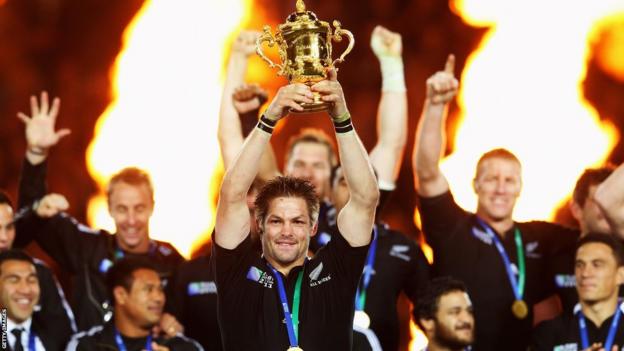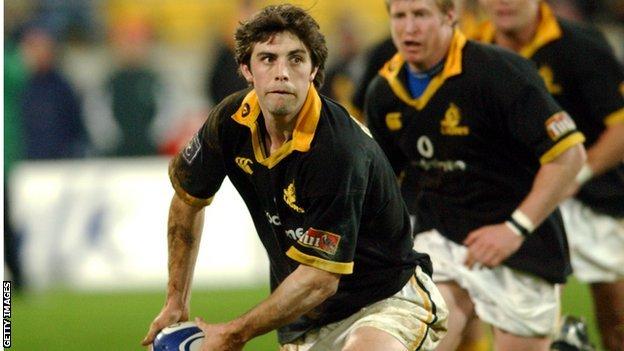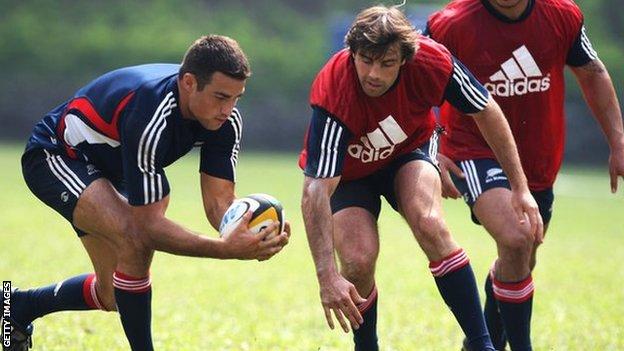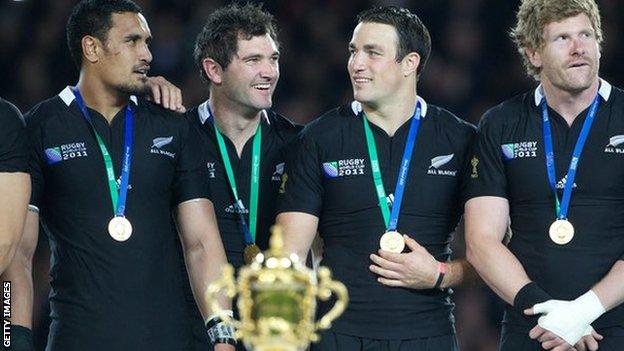

Sign up for notifications to the latest Insight features via the BBC Sport app and find the most recent in the
Everyone remembers their first day at school or in a new job; that feeling of being scared to either look out of place, or make a mistake.
Everyone has those days. But not everyone becomes an All Black.
In 139 years, just over 1,200 men have worn the shirt of one of rugby's most fabled and dominant teams.
They have won more than 77% of their Test matches - more than any other men's side. They have won three Rugby World Cups; no men's team have won more.
Their practices and cultures have become a byword for success, not just in sport, but in the wider world.
They are outstanding. But when you first join that hallowed club, the last thing you want to do is stand out.
"On my first day I was excited, but also terrified," says Richard Kahui, remembering his arrival in camp as a 23-year-old in 2008.
"I didn't want to be a disappointment - not be late to a meeting, or drop a ball in training.
"The first thing you do is meet the team manager, get your room key and all the new kit. That is as exciting as Christmas."
The kit symbolised being part of the team. But waiting for Kahui in the team room later that evening were two senior players - Conrad Smith and Keven Mealamu - with a black book that would reveal the special meaning behind becoming an All Black.
The call-up
Nowadays, players can be called up for international duty by simply being added to a WhatsApp group chat.
In 2004, Smith discovered his selection in a more public way.
New head coach Graham Henry was keen to blood some new talent after New Zealand lost to Australia in the semi-finals of the 2003 Rugby World Cup.
"I was in a flat by myself and wasn't even planning on listening to the announcement, but I realised the time and switched on the radio, with a sandwich in my hand," says Smith, who had only played one season of professional rugby at that point.
"Casey Laulala, an opposing centre, got named as it was in alphabetical order, and I remember thinking it might not be for me.
"It then got to S and my name got called out, so I put my sandwich down and my phone started going."

Four years on, Kahui didn't even have a radio. He had to ring All Black Stephen Donald - his best friend - who turned his phone on loudspeaker and put it next to a speaker so Kahui could listen to the announcement.
"Donald's name was called out before mine so I could hear his family screaming before quieting down," he says. "Then when it got further down, my name came out.
"My phone started ringing. My mum and dad were crying and I was nearly in tears.
"I found out just like everybody else."
The haka
The All Blacks' pre-match ceremonial war dance is one of rugby's iconic sights.
They insist it is not to psyche out the opposition; rather, it is for themselves. Some of the most meaningful performances of it are in private, away from the cameras and confrontation.
"When you are brought into the group there is a process and the haka is a big part of that, especially on a tour when there is a group of new players," says Smith
"On my tour [Europe 2004] there was seven or eight of us debutants, maybe more. You speak about yourself and your own journey - where you are from and a bit about yourself. Everyone welcomes you in.
"For the first haka, you face the established players and do it. There is a full team, it is so special and you talk, not just about the haka, but about the jersey, the legacy, the proud history of the All Blacks and that it is now your chance.
"The message was: 'Don't be daunted by it, you're meant to be here, and you are now the caretaker of the jersey so leave your mark on it.'"
Kahui's experience was similar.
"The squad welcome everyone into the room and do a massive haka to welcome you into the team," he says.
"Even speaking about it makes you feel funny.
"It is one of those energy-charged and emotional moments you have in your life and, at the end of it, you shake everyone's hand. When you walk out of that room you aren't treated or spoken to any differently - you are an All Black.
"You can sit at the same table as someone like Richie McCaw. You feel like you have every right to do things everyone else does. As a new player, as intimidating as it was on the first day, by the end of it, it felt like one of those special days you have in your life."
The little black book
Leaving your legacy and marking your time in the famous black jersey is the fundamental message for all newcomers. It goes beyond a metaphor. All Blacks literally write their own story.
When Smith and Mealamu approached Kahui on his first day, Smith - by now a senior player - handed him a black book.
"There are a few things that only All Black players get - one is a black book which has all the information you heard about in the meeting," says Kahui. "But it also comes with all these blank pages. You need to make a diary of your time as an All Black.
"Conrad Smith gave me his book after the meeting to have a look at. It had the date and the teams he played, how he felt, what it meant. It was really amazing to look inside his book and his mind.
"They say this is your book so cherish it and when you play your first game you give it back and they put a photo in of you playing and you have it for the rest of your life."
The book was introduced after Graham Henry took charge after the 2003 World Cup. Smith believes cultural change was needed, and praises for helping to implement the shift.
Enoka would eventually establish himself as head of leadership management and mental skills for the All Blacks. Initially, though, his ideas were treated with suspicion, and he had to pretend to be a masseur.
He was a big driver behind the introduction of the little black book.
"There were differing beliefs about the book, but the main idea was that it symbolised the All Blacks," says Smith. "The first few pages were about the legacy and gave a bit about the history and what they had achieved."

The book explained how New Zealand's many cultures were united by the common love of the black jersey and the silver fern.
"Then there were the blank pages and it was up to you," adds Smith. "You didn't have to write in it - you could draw pictures in it and do whatever you wanted.
"I started writing notes from each game. I think you appreciate that playing one Test is special, so you want to make sure you want to play 10 or 20.
"I wrote things that I cherished from games. I didn't write it for all 94 Tests... after the first 20 or so, the notes got shorter. That isn't because they were less special, it was because I developed my own routine."
Smith and Kahui were rivals for a midfield spot, but the culture instilled in the All Blacks is that senior players help future stars.
"I think you don't appreciate how much you can help someone and you do it because you have been there before," says Smith. "I knew how important it was for Tana Umaga to speak to me when I started my All Black career, when I sat there quietly and told me everyone is nervous.
"That left an impression on me, so I knew when I was in that position, I was going to do that. It was the same for me with Richard, a guy I really respect and rate."
The winning culture and Rugby World Cups
Smith and Kahui both joined an All Black set-up under a shadow.
Despite being the world's pre-eminent Test side, since winning the first Rugby World Cup in 1987 they had fallen short in the following five editions of the tournament.
A crushing defeat by France in the 2007 quarter-final was the final straw. Something had to change.
"That team in 2007 was just as good, if not better, than the teams [that won the World Cup] in 2011 and 2015," said Smith, a veteran of all three tournaments.
"We just didn't have that mentality quite right or prepared for a World Cup as well as we did in 2011 and 2015.
"We realised there were shortfalls around that in World Cups and we had to alter that. Although that attitude we had was brilliant to keep the All Blacks at that level, we still had to adjust that for a World Cup.
"We had to recognise the uniqueness of a tournament can throw up new challenges."
In 2011, Smith and Kahui both started the most pressurised game in New Zealand rugby history; one that threw up a challenge to test even the best-prepared team.
Four years after their shock defeat by the French in the last eight, they faced the same opposition again, in the final, on home turf. Victory would end a 24-year wait for the game's biggest prize.
"We worked hard on things like mental skill stuff - staying in the blue and not the red," says Kahui. "Blue is being calm and staying in the moment, not thinking about the outcome. Red is the negative thoughts, when you are thinking, 'what if?'"
Few had considered the possibility of what actually happened.
Injuries had ruled out first and second-choice fly-halves Dan Carter and Colin Slade. After 34 minutes, Aaron Cruden - the All Blacks' third-choice 10 - was also gone.
Cue Kahui's old friend. Half a stone overweight, when Henry rang him and asked him to join the squad before the semi-finals.
Now, with a jersey several sizes too small on his back and the outsized weight of a nation's expectations on his shoulders, it came down to him to reel in the World Cup.
Donald duly slotted a decisive penalty in a nervy 8-7 victory.

Kahui says the lessons from a series of World Cup disappointments - that the tournament demanded an extra level of preparedness and mental fortitude be added to the fabled All Black culture - paid off.
"In training, in 2009 and 2010, we did scenario training where he lost two fly-halves," he says.
"So in 2011, when we lose three, it felt like we had prepared for it.
"Looking back I see how much planning went in and the process of winning a World Cup. It is not a one-year thing. You get four years to get it right. The planning from the staff and leadership group was phenomenal."
Both Smith and Kahui have now retired.
There are new custodians of their famous black jerseys, and new legacies to be written.
The next two weeks will show whether the pages of their own black books include a record-breaking fourth World Cup, and another glorious chapter in All Black history.

Comments
Join the conversation